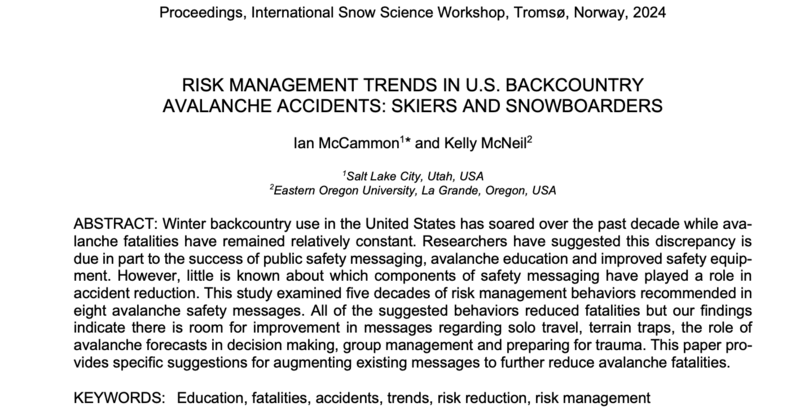
Drew Hardesty
Forecaster
Risk Management Trends in US Backcountry Avalanche Accidents: Skiers and Snowboarders
Ian McCammon and Kelly McNeil

The full paper can be found HERE
In this paper, longtime researchers Ian McCammon and Kelly McNeil set out to look at historical avalanche safety messages to see if they were still relevant and how they might be updated. What follows is a set of updated safety messages to help us better calibrate our planning and preparation and therefore reduce our overall avalanche risk in the backcountry. Below are a set of six simple, actionable recommendations.
HERE'S WHAT YOU NEED TO KNOW:
1***Carry a spare beacon to the trailhead and ALWAYS do a beacon check.
Many recent victims left their beacon in the car, in the bottom of their pack, or failed to turn on the beacon at the trailhead.
2***Practice companion rescue AND Learn backcountry first aid skills, including dealing with trauma and bleeding.
Trauma now accounts for 50% of the mortality rate. The old statistics were just 25%.
3***Don't travel Alone...but if you do, do the following:
Reduce your risk by avoiding avalanche terrain, sharing your route with family/friends, wearing a beacon, and using a satellite tracking device (ie: Spot or InReach or Strava)
4***Understand the Avalanche Forecast. Stick to your original route plan.
Stick to the plan. If you rule out certain aspects and elevations in the morning, don't change your mind during the day. Many accidents have occurred after the party changed their plans and drifted into more dangerous terrain during the day.
5***Recognize Avalanche Terrain. Don't overlook terrain traps.
Terrain traps are commonly overlooked in regards to avalanche terrain assessment. Ask, "What will happen if it slides?"
6***Go One At a Time.
Research indicated that many perceived "safe zones" were not. Similarly, many accidents occurred when parties went one at at time for the first two riders, but then the following riders did not wait...and triggered the avalanche.
From the authors of the study - Perhaps the greatest risk to these parties was not the avalanche conditions or the terrain, but their confidence that their risk management skills could overcome the avalanche danger they were trying to avoid.
Thank you for sharing this. Keep up the excellent work!
Jay W (not verified)
Thu, 1/2/2025
- reply
Drew,
Thanks for the research-based tips, as well as today’s superbly composed forecast. Felt like I absorbed highly relevant information filtered thru wisdom.
Erik K (not verified)
Thu, 1/2/2025
7) Never discount “the pucker factor”. When all the above is said and done for those who are “in touch”, never ignore your intuition. Just as science has proven the effectiveness of the placebo effect if you dig you will find that intuition is Real.
Dave Klein (not verified)
Sat, 1/4/2025






